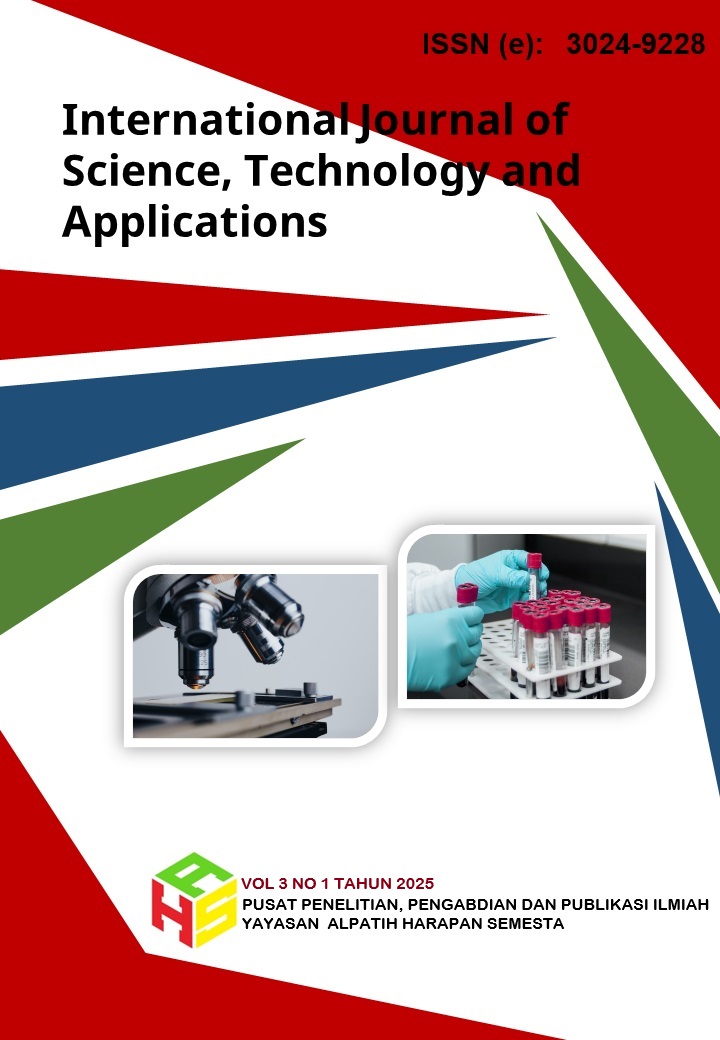Standardization of Simplisia of Dutch Teak Leaves (Guazuma ulmifolia) and Root of Mud (Rheum officinale)
DOI:
https://doi.org/10.70115/ijsta.v3i1.272Keywords:
Guazuma ulmifolia, Rheum officinale, simplisia, standardization, , Indonesian Herbal PharmacopoeiaAbstract
Standardization of simplicia is one of the important stages in ensuring the quality of herbal simplia. This study aims to conduct specific and non-specific standardization of simplicia of Dutch teak leaves (Guazuma ulmifolia) and kelembak root (Rheum officinale) based on the parameters of the Indonesian Herbal Pharmacopoeia (FHI) 2017. The parameters tested included moisture content, total ash content, insoluble ash content, drying shrinkage rate, ethanol soluble juice content, and water soluble juice content. The results showed that the simplicia of Dutch teak leaves had a moisture content of 7.90 ± 0.27%, a total ash content of 8.53 ± 0.19%, an acidic insoluble ash content of 1.95 ± 0.52%, drying shrinkage of 4.36 ± 0.28%, the content of ethanol soluble juice 26.20 ± 0.79%, and water-soluble juice 16.29 ± 0.44%. Meanwhile, the root of the pond showed a moisture content of 3.93 ± 0.25%, a total ash content of 5.76 ± 0.90%, an acidic insoluble ash content of 0%, drying shrinkage of 3.23 ± 0.09%, the content of ethanol soluble juice 88.6 ± 1.03%, and water-soluble juice 3.11 ± 0.51%. All non-specific parameters meet the requirements of FHI. The high value of ethanol-soluble juice in the root of the lembak indicates the richness of semipolar compounds, while Dutch teak leaves excel in the content of polar compounds. These results suggest that both simplicia are suitable for use as raw materials for phytopharmaceuticals, either singly or in combination, particularly in the development of herbal products for metabolic disorders
References
Clementi, E., & Mitchell, F. (2010). Chapter 27. Potential Health Benefit of Rhubarb. In Bioactive Foods in Promoting Health (pp. 407–423). Academic Press. https://doi.org/https://doi.org/10.1016/B978-0-12-374628-3.00027-X.
Fikayuniar, L., Kuswanti, A., Rahmawati, E. S., Immelia, R. P., & Ismayanti, S. (2023). Identification of Non-Specific Parameters of Telang Flower Ethanol Extract (Clitoria ternatea L.). Scientific Journal of Educational Vehicles, 9(16), 502–508. https://doi.org/https://doi.org/10.5281/zenodo.8248015
Guntarti, A., Sholehah, K., Irna, N., & Fistianingrum, W. (2015). Determination of Non-Specific Parameters of Ethanol Extract of Mangosteen Fruit Peel (Garcinia mangostana) in Variations of Regional Origin. Journal of Pharmacy, 2(5), 202–207.
Ministry of Health of the Republic of Indonesia. (2017). Indonesian Herbal Pharmacopoeia Edition II. In Ministry of Health of the Republic of Indonesia. Ministry of Health of the Republic of Indonesia.
Kinanthi Pangestuti, E., & Darmawan, P. (2021). Analysis of Ash Contents in Wheat Flour by The Gravimetric Method. Journal of Chemistry and Engineering, 2(1), 16–21.
Kumar, N. S., & Gurunani, S. G. (2019). Guazuma ulmifolia LAM: A review for future view. Journal of Medicinal Plant Studies, 7(2), 205–210. https://www.plantsjournal.com/archives/2019/vol7issue2/PartC/7-2-29-548.pdf
Michelin, D. ., Almeida, G. ., Galina, K. ., Lopes, G. ., Nakamura, C. ., Dias Filho, B. ., Ueda-Nakamura, T., Salgado, H. R. ., & Palazzo de Mello, J. (2010). Antidiarrheal acctivity of Guazuma ulmifolia Lam. (Sterculiaceae). Latin American Journal of Pharmacy, 29(6), 1024–1028.
Nurhasanah, & Iriani, D. (2021). Histochemical Test of Root, Petiole and Leaf of Butterfly (Rheum officinale Baill.). Journal of Tropical Biology, 21(3), 726–733. https://doi.org/10.29303/jbt.v21i3.2858
Sazali, M. (2017). Biologi Sel dan Molekular (1st ed.). LP2M UIN Mataram.
Smaradhna, S., Az Zahra, Z., Maria Sidabutar, C., Eskalatin, K., Tamzil, N. S., Lusiana, E., Oktariana, D., Dwi Prasasty, G., & Parisa, N. (2023). Potential of Dutch Teak Leaves (Guazuma Ulmifolia) as Antioxidants and Anti-Inflammatories Agent. International Journal of Islamic and Complementary Medicine, 4(1), 9–16. https://doi.org/10.55116/ijicm.v4i1.57
Tiwari, U., & Cummins, E. (2013). Factors influencing levels of phytochemicals in selected fruit and vegetables during pre- and post-harvest food processing operations. Food Research Interventional, 50(2), 497–506. https://doi.org/https://doi.org/10.1016/j.foodres.2011.09.007.
To'bungan, N., Atmodjo, P. K., & Yulistiyanto, A. C. (2025). Free Radical Inhibitory Activity And Phytochemical Properties Ethanolic Extract of Guazuma ulmifolia Leaves and Rheum officinale Roots. Biology News, 24(April), 121–131. https://doi.org/10.55981/berita
Ulfah, M., Priyanto, W., & Prabowo, H. (2022). A Study of Water Content on the Shelf Life of Vegetable
Sazali, M., Soesilohadi, R. C. H., Wijayanti, N., Wibawa, T., & Ansori, A. N. M. (2024). In Silico Analysis of C-Type Lectins as Co-Infection Receptors of Dengue and Chikungunya Viruses in Aedes aegypti. Makara Journal of Science, 28(5), 63–71. https://doi.org/10.7454/mss.v28i1.2224
Sazali, M., Soesilohadi, R. C. H., Wijayanti, N., & Wibawa, T. (2020). Aedes aegypti L . Controlling based on Lethal MosquitoTRAP Modification ( LMM ) in Mataram City. International Conference of Science and Engginering, July, 441–445
Simplisia Functional Drink Wedang Rempah. Journal of Basic Education and Social Humanities, 1(5), 1103–1112.
Wibowo, F. ., Tutik, & Amalia, P. (2024). Quality Standardization of Shallot Peel Simplicia (Allium cepa L.). Journal of Pharmaceutical Analysts, 9(2), 163–172.
Downloads
Published
Issue
Section
License
Copyright (c) 2025 Nelsiani To'bungan

This work is licensed under a Creative Commons Attribution-ShareAlike 4.0 International License.







